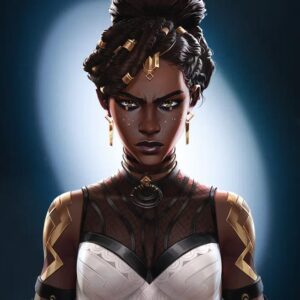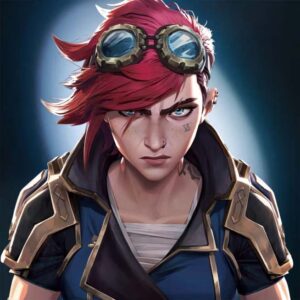
The female characters in Arcane—Jinx, Vi, Caitlyn, and Mel—may not be explicitly titled as “princesses,” but they are, respectively, the daughters of the new power in the Undercity, the old power in the Undercity, the most prominent family in the Upper City, and a foreign political regime. If we view “princess” as a symbolic identity or a starting point for female role models, these characters undoubtedly fit that meaning.
Although the term “princess” might oversimplify their vivid and multifaceted personalities, considering it as a framework to explore female archetypes could help us better analyze the power and value they represent.
For many children who grew up during the Disney era, princess stories were like a magical mirror reflecting an idealized world. From Cinderella to The Little Mermaid, and later Elsa and Anna in Frozen, these characters embodied dreams, love, and familial bonds. They were beautiful and kind, overcoming hardships to eventually achieve a happily-ever-after.
During my upbringing, despite being deeply immersed in these enchanting Disney princess tales, I could never truly see them as role models or the type of person I aspired to become.
Their stories often felt overly idealized, with problems frequently solved through external forces—especially rescue or support from male characters. This passivity felt distant from real-life experiences and failed to resonate with me on a deeper level. In contrast, the character portrayals and storylines of Arcane‘s “princesses” exhibit strong autonomy and realism, showcasing a truly inspiring form of female empowerment.
What Should a Princess/Woman Be?
Disney princesses are often characterized by purity, kindness, and beauty. Especially in the early days, Disney princesses largely lacked agency, with their destinies driven by male characters: Snow White was saved by the prince’s kiss, and Cinderella’s fate changed because of a glass slipper. Although more recent characters like Elsa from Frozen and Merida from Brave have started to show independence, they still lean towards an idealized, fairy-tale design. Their inner conflicts are minimal or one-dimensional, making them susceptible to the stereotype of the “perfect role model.”
In contrast, Arcane’s female characters are multifaceted and flawed.
–
Caitlyn

Caitlyn’s aristocratic background is neither her pride nor her crutch. Initially, she is steadfast in her ideals and deliberately distances herself from her family’s title, committing herself to frontline law enforcement to fight for justice for the common people. However, in her pursuit of Jinx—her mother’s killer—and to stabilize the city’s unrest, she eventually leverages her noble status, becoming a key figure in perpetuating the conflict between Piltover and Zaun.
When Caitlyn finally captures Jinx, she realizes that endless hatred and revenge only perpetuate cycles of harm. To break this senseless conflict, she consciously lets Jinx go, choosing an unconventional path to resolve their stalemate. By the end, she returns to her original role as an enforcer, continuing her fight for justice.
–
Jinx

Jinx’s strength comes from her creativity and destructive power. Under Silco’s guidance, she could fully unleash her talents—unlike in her childhood, when Vi constantly protected her. Silco gave Jinx unconditional acceptance, unlike Vi, who always wanted her to “get better.” Loyal to Silco’s vision, Jinx sparked the war between the twin cities. She followed her instincts without seeking glory, yet the people of Zaun saw her as a hero. Raising Powder (Isla) gradually taught her responsibility. After saving Isla, reconnecting with Vander, and reconciling with Vi, she rekindled hope—only to lose everything again due to her uncontrolled arcane powers.
After surviving a suicide attempt and being persuaded by Ekko, Jinx became a key figure in defending Piltover against external threats. During the final battle, she had a chance to save Vi’s life—a pivotal moment tied to her identity crisis. As a child, after witnessing their parents’ death, Jinx comforted a grieving Vi. But being too young, she soon became the one Vi had to protect. Not until Vi was once again that powerless little girl did Jinx finally reclaim her strength and become her truest self.
–
Mel

Mel’s power lies in her political intelligence and masterful manipulation. She uses the council as her stage, shaping the world’s future with words and strategy. She skillfully wields her background, charm, and cunning to achieve her goals, never becoming anyone’s pawn. Upon discovering her magical potential, she didn’t immediately join the sorcerers but carefully navigated the situation while maintaining control.
In matters of emotion, Mel is equally intentional. She knows the future she wants and the partner she desires, boldly expressing her feelings and guiding outcomes toward her vision. After the final battle and her mother’s death, she chose to return to her family and take responsibility, driven by her own will. She is proactive, charting her own path without being swayed by circumstances.
–
Vi

Vi despised the enforcers who killed her parents, yet in searching for Jinx, she developed feelings for Caitlyn, an enforcer. At first, Vi suppressed her emotions for Caitlyn to stay close to Jinx. Later, after Jinx bombed the council, Vi repressed her feelings for Jinx to join Caitlyn in hunting her down. During the pursuit, to prevent Caitlyn from making a mistake driven by hatred, Vi let Jinx escape—sacrificing her relationship with Caitlyn.
Caught between two opposing loved ones, Vi lost her will to live. Only after Caitlyn and Jinx reconciled did she resolve to live with Caitlyn, whose ideals aligned with hers. Vi always shields her loved ones with her fists, standing in harm’s way for them. Yet, her indecision and avoidance often emotionally hurt them. However, when she chooses to give her heart, she does so with honesty and protects those she cherishes with unwavering strength.
These Arcane “princesses” are far from perfect. Their emotions and flaws are sincere and real, yet each displays a unique form of female strength. Through their actions, influence, and emotional expression, they pave the way for diverse and profound representations of female role models.
Embodiment of Female Power: Beyond the “Damsel in Distress” Trope
In Disney princess narratives, female power is often portrayed through “inner beauty” or moral choices. Snow White’s purity wins over the Seven Dwarfs, and Belle transforms the Beast through love and compassion. However, this form of strength is confined to a non-realistic framework, lacking emphasis on concrete action. Even characters like Elsa from Frozen, who possesses formidable powers, primarily focus on self-acceptance. Despite her abilities, she remains a princess waiting to be saved, without challenging external power structures.
In Arcane, female power is far more grounded in action and tangible influence:
Caitlyn possesses detective-like insight and dares to confront power and corruption. When seeking revenge or redemption, she fully leverages her noble title; when pursuing love, she confidently embraces her physical allure.
Jinx wields devastating destructive power. As a pivotal figure capable of disrupting the balance between Piltover and Zaun, she can either be a terrorist breaking the city’s fragile peace or a savior protecting Piltover in critical moments—depending on where her heart leads her.
Mel seeks balance in a power-struggle-filled world through political strategy and emotional intelligence. As an exiled royal, she doesn’t passively accept her fate but actively penetrates the core of power, securing support for emerging forces.
Most intriguingly, Vi, a character who always throws the first punch, mirrors the traditional princess arc the most. Both Jinx and Caitlyn undergo character growth because they “save” Vi. Yet, unlike traditional princesses who inspire others with a flawless heart, Vi’s journey is driven by relentless action and collision with others. Through persistent effort to convey her beliefs, she ultimately reaches her destination.
Diversity and Authenticity: Liberation and Challenges for Female Characters
Early Disney princesses have been criticized for lacking diversity. Even with recent reforms introducing more diverse casting, Disney still faces criticism for being politically correct. Despite surface-level changes, most princesses still follow the formula of being “brave,” “kind,” and “selfless.”
In contrast, Arcane’s female characters present richer psychological depth and diversity:
Caitlyn is an idealistic noble pursuing justice but is also willing to exploit her class privilege when necessary.
Jinx, a psychologically scarred and brutal agitator, blurs the line between hero and villain.
Mel isn’t driven by a sense of duty toward her people or family but by personal ambition and a desire for recognition.
Vi embodies “bravery,” “kindness,” and “selflessness,” yet these traits often hinder her progress until she chooses to let them go.
This diversity shows that female strength isn’t limited to being “brave,” “kind,” or “selfless.” It can manifest through different identities, motivations, and stories, offering a rich and complex portrayal of life.
Conclusion: The Ideal “Princess” Archetype
In Arcane, I finally discovered a “princess” archetype fundamentally different from traditional fairy tales. These characters are far from perfect—they are flawed and complex. Yet, it is precisely this imperfection that allows them to embody genuine and diverse female strength. Jinx’s madness hides loneliness, Vi’s resilience conceals vulnerability, Caitlyn’s ideals are balanced by compromise, and Mel’s ambition is grounded in integrity. These women are no longer lofty, untouchable symbols of royalty but relatable individuals who resonate deeply with audiences.
Compared to Disney’s traditional princesses, Arcane’s female characters are not passive figures waiting to be rescued. They are driving forces in the narrative, portraying the complexity and diversity of real life. They transcend the simplistic, idealized role models of the past.
Their stories reveal that true strength comes from recognizing one’s limitations and finding personal solutions in adversity. For me, Arcane’s female characters have redefined the meaning of “princess.” The ideal female role model is no longer a dreamlike figure—beautiful, moral, and pure—but a grounded, multifaceted individual who dares to embrace her desires and shines with diverse brilliance.


